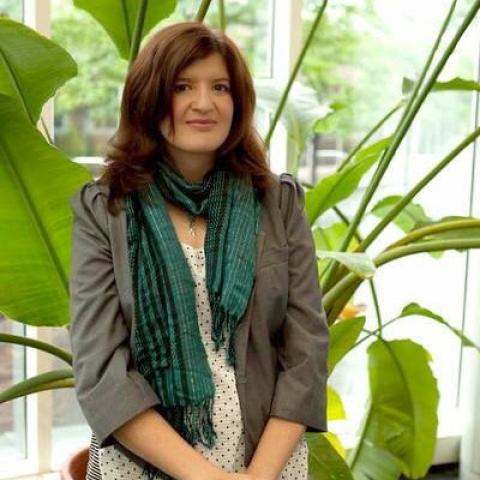Jarenski says the students found the weekly exercises to be entertaining, informative and interactive. “It was a place where they could take what they were seeing when scrolling online and get more information about it, while also connecting with other students,” Jarenski says. “My goal was media literacy and creating good information evaluation habits. They, according to the surveys and participation level, saw it as their favorite assignment in the class.”
Out of 61 students' survey responses about the SIFT method and assignment, Jarenski says 59 responded “yes” or “maybe” to the question, “Would you use SIFT again?” Survey comments included how the SIFT method could assist them in grad school and in their careers; they also liked having a tool that helps better navigate generative AI and the increasing amount of misinformation they’re finding on social media sites.
UM-Dearborn senior Sophia Siddique, who took Jarenski’s class, says the assignment helped her sort through “news” she sees online and is grateful for the skillset she's gained.
“It’s amazing how much you can find out fast using the SIFT method,” Siddique says. “Before I would see articles that said the opposite things about the same topic and wasn’t totally sure which was true. I now know how to check the claims and sources to see which one is more accurate. It’s changed the way I take in information.”
Following the student feedback showcasing the success of the summer pilot, the College of Arts, Sciences and Letters Foundations program will implement Curate and SIFT as a common assignment for teaching the SIFT method for digital information literacy in the classroom this fall. In addition, educators across the university’s four colleges plan to incorporate a form of the SIFT method into their courses.
“I did it in a way that plays off the ‘show and tell’ idea, but it can be adapted into any classroom and for any subject,” Jarenski says. “When I first started, I wasn’t sure how my students would view the assignment. Would they see value in it? Would it be a chore? But the more they did, the more they enjoyed it. It was a game-changer for me; I’m going to incorporate it moving forward. And there’s a teaching module on building these digital media literacy lessons into the classroom that is easy to apply. It’s really plug and play.”
This importance of sorting through the vast amounts of unattributed claims everyone sees online — and doing it quickly — is among the reasons the Faculty Senate’s First-Year Committee chose “Verified” as the Community Read. History Associate Professor Kristin Poling says, for the first time, campuswide suggestions were collected in advance of selecting the book. Multiple entries recommended “Verified.” Poling is a Community Read co-chair.
“We want reliable sources. We don’t want to be tricked. So who can we believe? This book gives us tools to have a stronger trust in ourselves when evaluating materials. It’s a useful, easy and interesting read where each chapter presents clear examples on the topic that’s presented,” says Poling, who will incorporate the SIFT method into her upcoming History of Childhood course. “I’ve learned new strategies that I now use myself.”
Poling says media literacy is an important topic in the workplace, classroom and at home. And she sees the combination of the book and the common assignment as a way to set students up for success. “Media literacy is useful in all aspects of our lives, no matter what we are studying or the field we work in,” Poling says. “With the advance of new generative AI and other tools, we will need to know how to use them responsibly and evaluate their output. Getting educated on how to spot disinformation is an important step in stopping the spread.”
Interested and want to get involved with this year’s Community Read? Here’s how:
- Reserve a free copy of “Verified,” while supplies last.
- Attend a teaching workshop. It’s open to all instructors and takes place 1 p.m. Sept. 23 in Mardigian Library, room 1211. During the event, faculty who teach digital information literacy share how they are implementing “Verified” in their courses.
- Check out this guide to the SIFT method for evaluating web content.
- Listen to an interview with “Verified” author Mike Caulfield on the “Teaching in Higher Ed” podcast with Bonnie Stochoviak, the Hub’s Fall 2023 Scholar in Residence.
- Explore a teaching module on lateral reading from “Verified” author Sam Wineburg’s Civic Online Reasoning program; access is free with registration.
- Schedule a meeting with a Hub instructional designer to discuss how to use “Verified” in your class.
Faculty Senate First-Year Experience Committee members — who selected the 2024-2025 UM-Dearborn Common Read — are Mitchell Business Communication Lab Director and Business Communications Lecturer Jennifer Coon, Dempsey, Assistant Director and Senior Advisor for First Year Initiatives Lynda Dioszegi, CECS student Alma Fawaz, Dean of Students Amy Finley, Health Communication Associate Professor Nick Iannarino, Campus Wide & Family Programs Coordinator Jennifer Kowalczyk, Director of Enrollment Management Communication and Events Kevin Lewtschanyn, Composition and Rhetoric Associate Professor Michael MacDonald, Poling, Public Health Associate Professor Natalie Sampson and Mathematics Assistant Professor Tian An Wong.
Story by Sarah Tuxbury.




